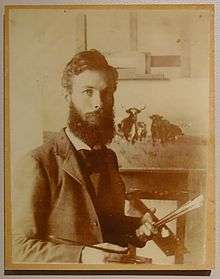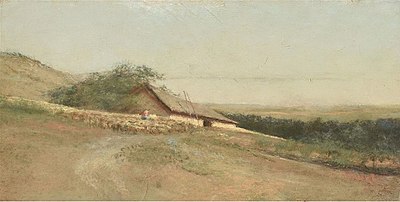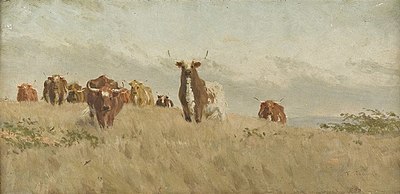Frank Reaugh
Charles Franklin Reaugh (December 29, 1860 – May 6, 1945), known as Frank Reaugh, was an artist, photographer, inventor, patron of the arts, and teacher, who was called the "Dean of Texas Painters". He devoted his career to the visual documentation in pastel and paint, portraying the vast, still unsettled regions of the Great Plains and the American Southwest. He was active in the Society of Western Artists.[1]
Charles Franklin "Frank" Reaugh | |
|---|---|
 Frank Reaugh | |
| Born | December 29, 1860 |
| Died | May 6, 1945 (aged 84) Dallas, Texas |
| Occupation | Artist; Photography, Inventor; "Dean of Texas Painters" |
| Spouse(s) | Never married
(1) As a youth, Reaugh went on cattle drives which awakened his interest in nature. (2) Many of Reaugh's paintings are located in the Panhandle-Plains Historical Museum in Canyon (3) Though based in Dallas, Reaugh went on field trips into the American Southwest to obtain inspiration for his paintings. |
Early years as budding artist
Reaugh was born to George Washington Reaugh, a miner in the California gold rush, and the former Clarinda Morton Spilman[1] near Jacksonville, the seat of Morgan County in west central Illinois. Reaugh (pronounced RAY), moved with his family in 1876 to Terrell in Kaufman County east of Dallas. The original family name was "Castelreaugh", but the Irish family shortened it to "Reaugh" when they entered the United States. The Reaughs initially made their living in Terrell by planting cotton.[2]
Reaugh developed his skills by copying the works of European masters from magazines and from illustrations of larger animals in anatomy books. He studied the writings of naturalists Louis Agassiz and John Burroughs. In the early 1880s, he was invited by the cattlemen brothers Frank and Romie Houston to join them on cattle drives near Wichita Falls in Wichita County south of the Red River.[1] The Houstons may have also provided financial support for Reaugh to further his artistic studies.[3]
During the winter of 1884–1885, Reaugh studied at the School of Fine Arts in St. Louis. From 1888 to 1889 he spent time at the Académie Julian[4] in Paris. Here he became interested in pastels at The Louvre museum.[3] Influenced by La Tour and realist Anton Mauve, he also studied Flemish and Dutch paintings in Belgium and the Netherlands, where he was inspired by the work of Paulus Potter.[5]
In 1890, the Reaughs moved from Terrell to the Oak Cliff section of Dallas.[2] There, he and his father built a metal studio building in the back yard called "The Iron Shed". Reaugh's works soon gained attention and national recognition through art exhibitions, including showing at the World's Fairs in Chicago (1893) and St. Louis (1904).[3]
Prolific painter

Ultimately, Reaugh created more than seven thousand works. He concentrated on small plein air pastel sketches of the wild and colorful Texas Longhorn, a subject he found challenging to illustrate. He once said that "no animal on earth has the beauty of the Texas steer."[6] Reaugh recalled that his mother had particularly encouraged him in the mastery of painting true-to-life forms: "I would sit in the midst of the herds to study their form, the workings of their muscles, their character and habits, their characteristic spots and markings, and their wonderfully rich and varied colors."[6]
His leading paintings include:
- Watering the Herd (1889)
- The O Roundup (1894)
- Grazing the Herd (1897)
- The Approaching Herd (1902)
- Twenty-Four Hours with the Herd (seven paintings, after 1930)
- Texas Cattle (April 1933, his last major work)[5]
Reaugh as inventor
Reaugh created his own art materials and tools, including a patented folding lap easel and compact carrying case for pastels. He created and marketed his own brand of pastels, each cast in a hexagonal shape to facilitate handling in the field.[3] He patented a rotary pump and served on the board of directors for the Limacon Pump Company in Dallas.[1]
Reaugh as art instructor
Reaugh established an art school in Dallas in 1897. He was a model artist and an influential arts educator. For many years, Reaugh led groups of art students on sketching expeditions throughout West Texas, ranging into New Mexico and Arizona. His colleagues, Charles Peter Bock and Louis Oscar Griffith, sometimes accompanied him on these trips. Many of his students, including Reveau Bassett, Florence McClung, Harry Carnohan, Lucretia Donnell, John Douglass, Olin Travis, Edward G. Eisenlohr, Lloyd Goff, Alexandre Hogue, and Josephine Oliver, gained regional and national prominence. Several of these became part of the group known as the Dallas Nine. (Donnell, one of Reaugh's last students, has continued her mentor's tradition of taking students on sketching trips.[2]) Reaugh helped found the Dallas Art Society (later the Dallas Art Museum), The Frank Reaugh Art Club, and the Striginian Club. Frank Reaugh also championed the creation of the Dallas Museum of Art in the early twentieth century.
Legacy

Reaugh was passionate about his adopted state. Several of his paintings are displayed at the Texas State Capitol in Austin. Many of his other works are held by the Panhandle-Plains Historical Museum at West Texas A&M University in Canyon, where he shared the spotlight with fellow painter Harold Dow Bugbee, a former curator of the museum.[5] Other Reaugh works are at the Southwest Collection/Special Library Collection at Texas Tech University in Lubbock, and the Harry Ransom Humanities Research Center at the University of Texas at Austin.[1]
In February 1936, the aging Reaugh described his legacy in terms that his painting ". . . aside from any artistic merit that they may possess, will tell their story, and will be preserved because of historical value; for the steer and the cowboy have gone, the range has been fenced and plowed, and the beauty of the early days is but a memory."[3]
Reaugh's interest in western art was less on the human side than in the animals and the natural environment. In this respect, he was unlike Frederic Remington or Charles M. Russell, whose works stressed confrontation between man and nature. Reaugh saw the ideal of pastoral harmony through the herds that meandered across the prairie.
With the help of Lucretia Donnell, Reaugh wrote an autobiography entitled From Under the Mesquite Tree: An Artist's LIfe on the Texas Plains. Historian J. Evetts Haley in 1960 published F. Reaugh: Man and Artist.
In Reaugh’s will, dated May 16, 1940, filed before his death in Dallas County, the painter noted, “The main part of my property is in pictures… These are largely of the great prairies of Texas and the longhorned cattle of fifty years ago . . . It is my wish that these pictures be kept together if only for historical reasons. They create the spirit of the time. They show the sky unsullied by smoke, and the broad opalescent prairies not disfigured by wire fences or other signs of man."[6]
Having given away most of his possessions, Reaugh died in poverty in Dallas in 1945 at the age of eighty-four. He had vowed years earlier never to live anywhere outside of Texas. He is buried in Terrell Cemetery.[1]
In 2007, the exhibition "The Pastel Range: Frank Reaugh, Ranch Historian" appeared at the National Ranching Heritage Center in Lubbock, Texas. In 2015, the Harry Ranson Center in Austin, Texas, staged the retrospective exhibit "Frank Reaugh: Landscapes of Texas and the American West" and published the book Windows on the West: The Art of Frank Reaugh.
References

- "- Texas State Historical Association (TSHA)". tshaonline.org. Retrieved 7 October 2015.
- Frank Reaugh
- "The Frank Reaugh Collection". utexas.edu. Retrieved 7 October 2015.
- Michael Grauer, Rounded Up in Glory: Frank Reaugh, Texas Renaissance Man
- Reaugh exhibit at Panhandle-Plains Historical Museum, Canyon, Texas
- "Frank Reaugh". Archived from the original on 2008-11-21. Retrieved 2008-05-11.
Sources
- Michael R. Grauer. Rounded Up in Glory: Frank Reaugh, Texas Renaissance Man. Denton University of North Texas Press, 2016.
External links
| Wikimedia Commons has media related to Frank Reaugh. |
- Frank Reaugh: Landscapes of Texas and the American West exhibition at the Harry Ransom Center in 2015
- Frank Reaugh Collection at the Harry Ransom Center, University of Texas at Austin
- Texas Capitol Historical Art Collection
- Handbook of Texas Online – Charles Franklin Reaugh
- Frank Reaugh Gallery at the Panhandle Plains Historical Museum
- Frank Reaugh at Askart.com
- Papers, 1902–1960, in the Southwest Collection/Special Collections Library at Texas Tech University
- The Frank Reaugh digital collection from the Harry Ransom Center at The University of Texas at Austin.